Ever wondered, “Do aligners stain easily?” If you’re picturing a clear, confident smile only to find your trays turning yellow, you’re not alone. Let’s uncover the real reasons aligners stain and how you can keep your treatment – and your smile – crystal clear from start to finish.
Curious If Clear Aligners Stain Easily? Start Here
For anyone considering or already wearing clear aligners, such as Invisalign, one of the most common questions is, do aligners stain easily? The answer comes down to your daily habits and care. Aligners are designed to be virtually invisible, giving you a discreet orthodontic experience. However, like anything made to be clear, they can be vulnerable to discoloration, especially if you love coffee, tea, or other staining foods and drinks. Whether you’re a teenager, college student, or busy adult, understanding how and why aligners stain makes you more confident and proactive during your orthodontic journey. This article is here to deliver practical guidance—from what causes stains, to foolproof cleaning routines, to what to do if you notice your aligners aren’t as clear as they used to be. Read on to empower your smile with knowledge and proven solutions.
"Do aligners stain easily? Understanding the real risks puts you in control of your orthodontic journey."
What You'll Learn About: Do Aligners Stain Easily?
The true risk: Do aligners stain easily?
What materials make up clear aligners and how that affects stain resistance
Top foods, drinks, and habits that can discolor aligners
Proven tips to prevent stains and keep your trays crystal-clear
How to safely clean stains from Invisalign aligners and other brands
What to do if staining occurs, and when to seek orthodontist help
How aligners compare to metal braces in stain risk
Understanding Aligners: What Are Clear Aligners Made Of?
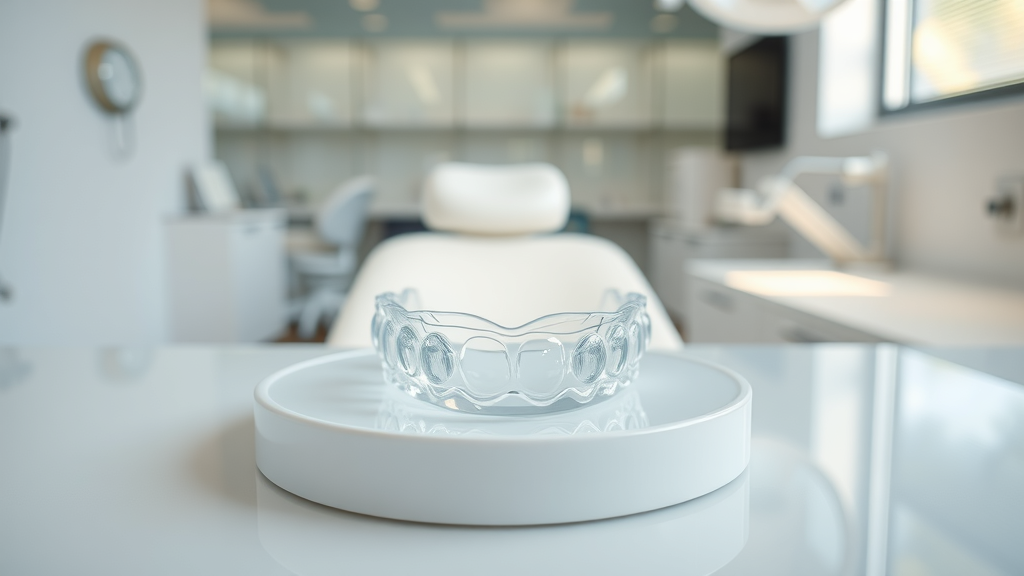
Material composition: How do clear aligners and Invisalign aligners interact with daily habits?
Clear aligners—including industry leaders like Invisalign—are primarily constructed from medical-grade thermoplastic materials, such as polyurethane resins and plastic polymers. These materials are engineered for flexibility, durability, and transparency, ensuring comfort and the much-desired "invisible" look. Still, their smooth surfaces can be micro-porous, meaning tiny pits or crevices may develop over time that trap pigments and debris from daily use. Your habits, like frequent snacking or sipping on drinks throughout the day, directly affect how susceptible your clear aligner trays are to staining. If you’re diligent about removing aligners when eating or drinking anything but water and stick to a good oral hygiene routine, you’ll minimize buildup. On the flip side, skipping proper cleaning or leaving trays in during meals allows color particles and oils to stick, stain, and even create odors, which can affect both your smile and confidence.
Why do clear aligner and Invisalign aligner trays stain at all?
No matter the brand or technology, aligners stain for one main reason: exposure to pigmented foods, drinks, and habits like smoking. Unlike your natural teeth, which have a protective enamel coating, thermoplastic trays are more vulnerable to absorbing pigments—especially if tiny surface scratches or rough patches are present. Foods like curry and tomato sauce, or drinks like red wine, coffee, and tea, are notorious for their intense natural or artificial colors that leach into plastic surfaces. Similarly, nicotine and tar from tobacco can discolor trays quickly. Over time and without proper care, minor stains can become visible yellow or brown marks, giving your aligners a cloudy, aged look. The combination of material science and daily choices means proactive care is crucial to prevent permanent discoloration and keep your aligners (and your smile) bright throughout treatment.
Comparison: Aligner Material vs. Stain Susceptibility |
|||
Aligner Brand |
Main Material |
Stain Susceptibility |
Special Features |
|---|---|---|---|
Invisalign |
SmartTrack™ Thermoplastic |
Moderate — with routine care |
Flexible, snug fit |
Candid |
Clear Resin Plastic |
Moderate-High |
BPA-free, slightly stiffer |
Byte |
Medical-grade Polymer |
Moderate-High |
Vibration technology compatible |
SmileDirectClub |
Proprietary Thermoplastic |
High — more porous |
Budget-friendly |
Do Aligners Stain Easily from Everyday Foods and Drinks?

Top staining culprits: How red wine, coffee, tea, curry, and more impact clear aligner trays
Most aligner wearers quickly realize that some foods and drinks create trouble for a clear smile. The biggest staining offenders? Red wine, black coffee, dark tea, curry, tomato sauce, soy sauce, and blueberries top the list. Each is packed with natural or synthetic pigments (like tannins, anthocyanins, or carotenoids) that can rapidly discolor aligner trays if contact occurs. When these substances interact with aligner plastic, their small pigment molecules may wedge into any micro-abrasions—resulting in yellow, brown, or purple-tinged aligners after just a few exposures. Even otherwise healthy choices like blueberries or pomegranate can stain, so don’t underestimate fruits!
It’s worth noting that eating or drinking hot drinks (like coffee or tea) while wearing aligners can also warp the trays, further trapping stains and making them harder to clean later. While some people think a quick rinse is enough, any leftover residue on the trays or in your mouth can speed up discoloration. Protect your smile by removing aligners before indulging in stain-prone foods and drinks, and thoroughly cleaning your teeth and trays before putting them back in.
Do habits like smoking cause clear aligners to stain easily?
Absolutely. Smoking, whether it’s cigarettes or vaping, rapidly increases the risk that your clear aligner trays will stain easily. Nicotine and tar are notorious for yellowing not just teeth but also plastic dental appliances. Even a single cigarette can cause noticeable discoloration on your aligner’s transparent surface. Those telltale yellow-brown marks are tough to remove and may never fully come out, even with soaking and scrubbing. If you’re hoping for a “stealth” orthodontic look and smoke regularly, you might be disappointed in how long your trays stay clear. The best prevention? Go smoke-free during aligner wear, otherwise you’ll need replacement trays more often and risk compromising your investment in a straighter smile.
In short, both smoking and food/drink stains can cause aligners to appear unsightly, make you self-conscious, and may even affect your motivation to wear them as prescribed—a lose/lose for your oral health and confidence.
Oral Hygiene and Its Role: Keeping Aligners Stain-Free
Oral hygiene: Why brush and floss before reinserting clear aligners matters
Good oral hygiene is the single most important habit for keeping clear aligners stain-free. After eating or drinking anything except water, you should always brush your teeth and, ideally, floss before putting your trays back in. Lingering food particles, sugars, and pigments stick to the surface of your teeth and quickly transfer to the plastic when aligners are reinserted. Over time, that sticky film becomes a breeding ground for stains, odors, and even tooth decay, undermining both your orthodontic and oral health goals. If you’re in a situation where you can’t brush and floss, at least rinse your mouth thoroughly with water and do a quick rinse of the trays. That said, skipping your cleaning routine even occasionally makes it much more likely your aligners will stain easily and may also risk gum inflammation or bad breath—none of which help your smile journey.
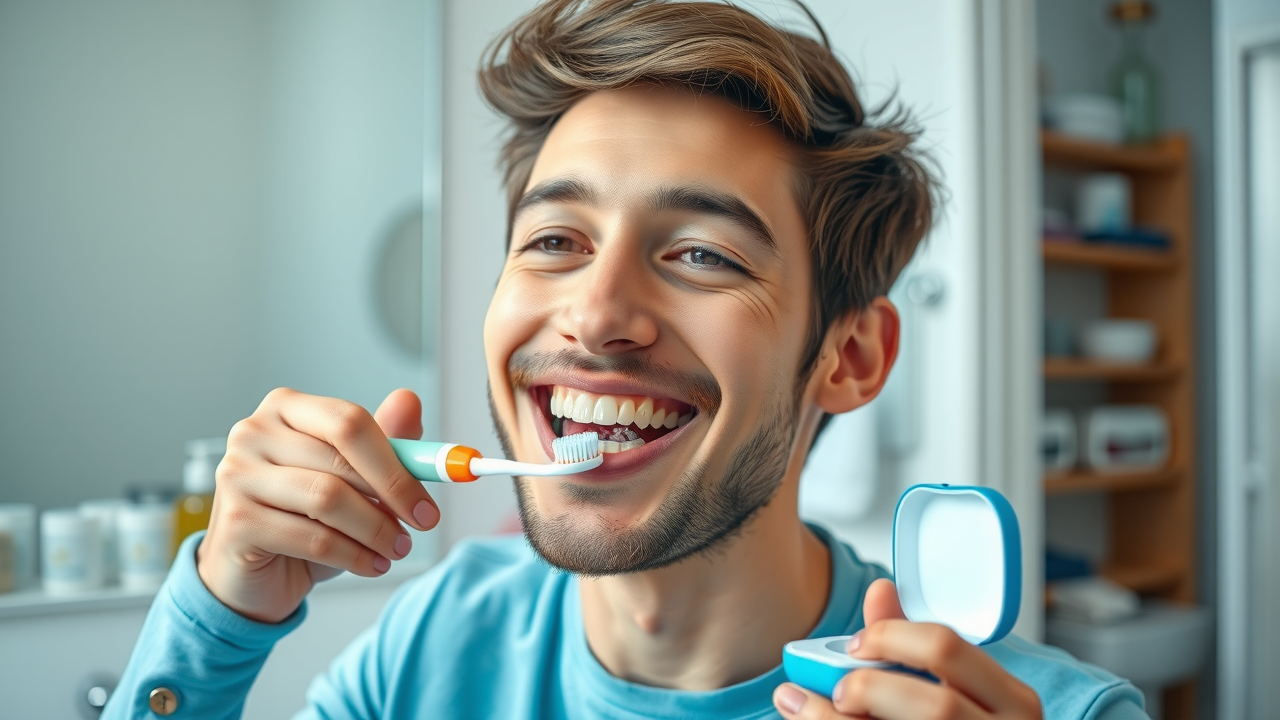
Best cleaning products and Invisalign cleaning crystals for reducing aligners stain
When stains strike, it’s tempting to reach for extra-strong cleaners. But the best option is to use cleaning products specifically formulated for orthodontic trays, like Invisalign cleaning crystals or branded cleaning tablets made for clear aligners. These gently dissolve stubborn debris and pigments without scratching or damaging trays. Avoid harsh household products (like bleach or whitening toothpaste) that can roughen the plastic surface, actually making it stain more easily. Always follow your orthodontist’s instructions, and stick to a routine—soaking trays daily, brushing with a soft toothbrush (no abrasive toothpaste!), and using a non-alcoholic, clear mouthwash for extra freshness. Good oral hygiene and the right cleaning products will keep your aligners as invisible as day one.
How to Prevent Aligners from Staining Easily
Always remove aligners before eating or drinking anything except water
Brush and floss thoroughly before reinserting trays
Soak aligners daily in cleaning crystals or a recommended solution
Rinse trays after removal if brushing is not possible
Avoid smoking and minimize consumption of stain-heavy foods/drinks
Replace trays as advised by your orthodontist to avoid buildup
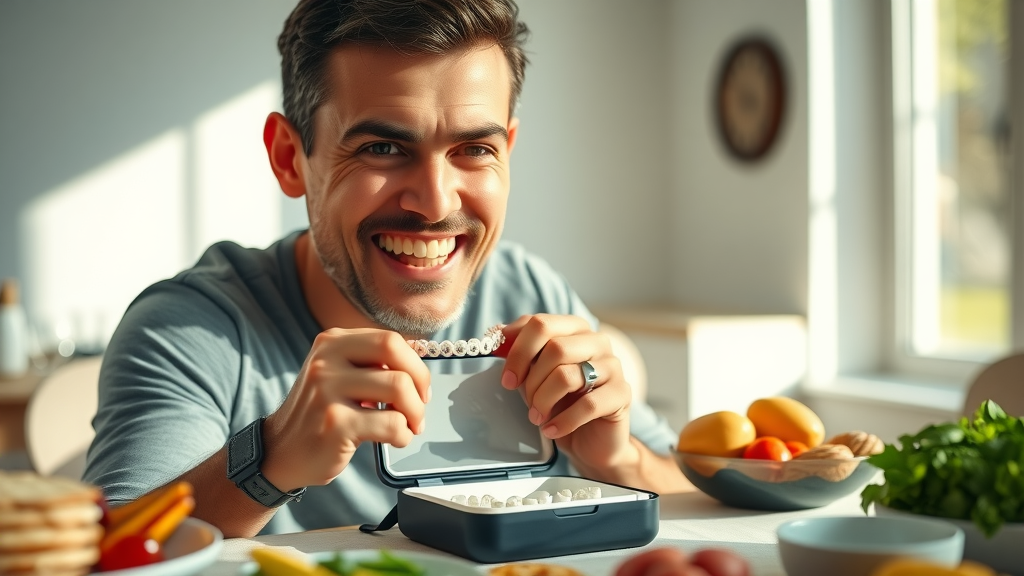
Practical tips: Removing aligners before eating or drinking
It may seem like common sense, but the most effective way to prevent aligners from staining is simply to take them out before eating or drinking anything except water. This isolates your clear aligners from direct contact with food colors, sugars, or carbonation, which can all encourage pigment absorption and tray cloudiness. Bring your aligner case everywhere, and don’t be shy about excusing yourself before meals. If you’re rushed, do a quick rinse with cool water; better yet, keep a travel toothbrush handy. Create a routine where you automatically remove, rinse, eat, brush, and reinsert. This proactive mindset pays off in fresher trays, brighter smiles, and more confidence throughout your orthodontic treatment.
Proactive versus reactive: Soaking, using cleaning crystals, and more
You can’t always control the unexpected—a surprise cup of coffee or snack with friends—but you can control your cleaning routine. Proactively soaking aligners in Invisalign cleaning crystals or specialized cleaning solutions at least once a day helps prevent light stains from settling in. If discoloration still happens, gently brush inside and out with a soft-bristled toothbrush—no abrasive cleaners, please!—and use a non-colored, unscented soap when needed. If stains persist, consult your orthodontist who may recommend safe professional options, or (if trays are especially damaged) provide replacements. Don’t wait until stains are visible: build proactive care into your oral hygiene routine for best results.
Do Different Brands Like Invisalign Aligners Stain Easily?
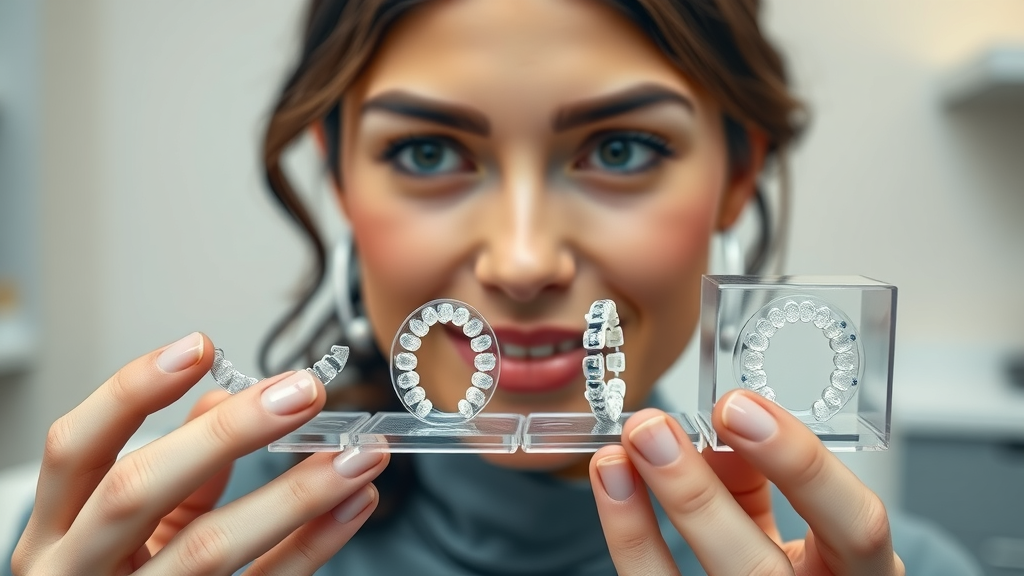
How do Invisalign aligners compare to other clear aligners in staining risk?
Not all clear aligners are created equal when it comes to staining. Invisalign aligners use patented SmartTrack™ thermoplastic, engineered for stain resistance and flexibility, but they aren’t immune from everyday pigment risks. Competing brands like Candid, Byte, and SmileDirectClub use similar plastics but may differ in porosity, fit, and thickness, which can affect how easily they take on color. For example, brands using slightly more porous plastics or less-polished surfaces may show stains from tomato sauce, red wine, or even herbal tea more quickly than Invisalign. If you’re comparing aligner brands, ask your provider about their specific material science and read up on user reviews regarding real-world staining incidents.
Ultimately, no matter which brand you choose, routine care remains the top defense. Opt for brands with the best reputation for clear, strong plastics if stain risk is a major factor for you. And remember: diligent cleaning and stain-avoidance habits surpass any minor differences in materials.
Stain Resistance: Top Clear Aligner Brands |
|||
Brand |
Stain Resistance |
Material |
Recommended Routine |
|---|---|---|---|
Invisalign |
Good |
SmartTrack™ |
Daily soaking; gentle brushing |
SmileDirectClub |
Moderate |
Proprietary Thermoplastic |
Frequent brushing; weekly soak |
Byte |
Good |
Medical-grade Polymer |
Nightly cleaner, gentle soap |
Candid |
Moderate |
Clear Resin |
Soak 2x/week; rinse after meals |
Does Staining Affect Invisalign Treatment or Are Stains Only Cosmetic?
"Stains may not impact your progress, but they do affect your confidence — and that matters in your smile journey." – Local Orthodontist
Most stains on Invisalign aligners and other clear aligners are cosmetic, meaning they don’t affect how well your trays move your teeth or your overall orthodontic treatment progress. However, cloudy, yellow, or brown aligners draw attention to your mouth (not in a good way!) and can make you feel embarrassed about smiling or speaking up. In rare cases, if stains are caused by plaque buildup, it can lead to gum inflammation, bad breath, or even harm your teeth underneath—especially if your oral hygiene routine is lacking. Keeping your trays clear helps maintain the confidence you deserve as your smile transforms.
What To Do If Your Aligners Stain Easily or Become Discolored
Can you remove aligner stains at home, or do you need professional help?
You can usually remove light aligner stains at home with the right approach. Start by gently brushing trays with a soft, non-abrasive toothbrush under lukewarm water. Use only toothpaste labeled safe for clear aligners, or better, a mild, color-free liquid soap. For stubborn stains, soak trays in Invisalign cleaning crystals or in a homemade solution (like diluted white vinegar, if your orthodontist approves it) for 20-30 minutes. Never use boiling water or harsh chemicals—these can warp the plastic or make stains worse! If stains persist, your orthodontist can evaluate the trays and decide if a safe in-office cleaning is possible, or if you should simply move to a new set.
Rinse aligners immediately after removal if you’re not able to clean them right away
Soak trays daily in an aligner cleaning solution or cleaning crystals
Gently brush with a soft toothbrush and non-abrasive soap
If stains won’t budge, call your orthodontist for advice
When to consider replacement aligner trays
Sometimes, no matter how careful you’ve been, trays take on stains that just won’t come out. This is usually a sign that it’s time to upgrade to your next set (if you’re following Invisalign or similar tray schedules). If your aligners get severely discolored early in a wear cycle, or if they become cloudy and can’t be cleaned, consult your orthodontist for a potential replacement. Remember, wearing heavily stained trays isn’t just about looks—they could harbor bacteria, residual sugars, or weaken over time and not move your teeth as planned. When in doubt, always ask your orthodontic team to help you keep your treatment safe and your smile bright.
Braces and Clear Aligners: Do Metal Braces Stain as Easily?
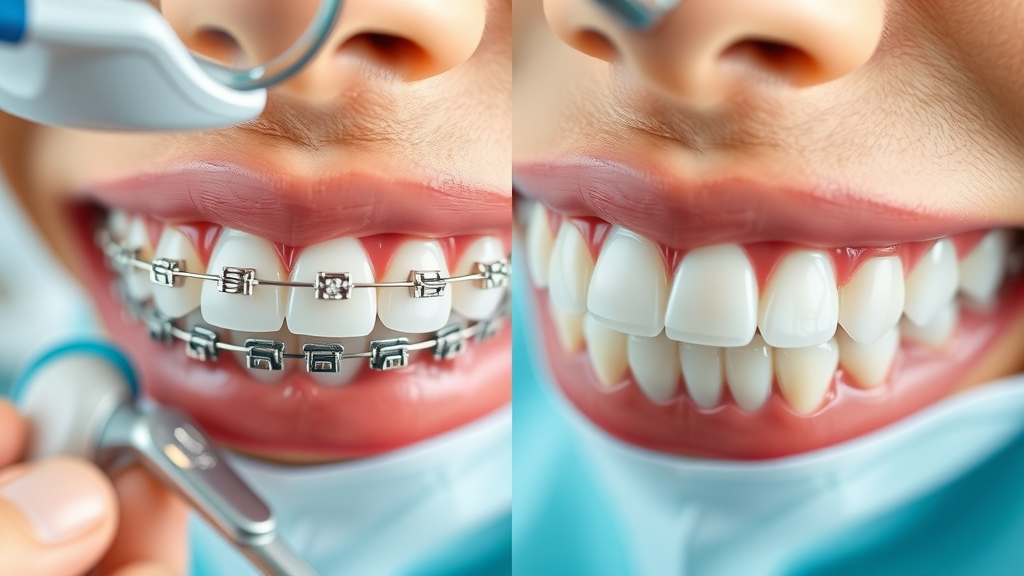
Metal braces versus clear aligners: Stain risk comparison
A major reason people choose clear aligners is to avoid the visible look and dietary restrictions of metal braces, but what about staining? Traditional metal braces themselves don’t typically stain—the metal is inert—but elastic ties, clear brackets, and the teeth around them can discolor from those same stain-causing foods and habits. Clear aligners, if cared for, can stay largely invisible, but they’re more prone to taking on tints from everyday life if you skip cleaning or indulge in coffee, red wine, or tomato sauce. In other words, while metal braces don’t stain as easily, both types of orthodontic appliances require good oral hygiene and routine cleaning to keep your smile healthy and bright. Choose the option that fits your lifestyle and commitment to daily care best.
If you love coffee, tea, or vibrant foods, know that proper habits are key for both braces and clear aligners. Set a strong oral hygiene routine regardless of which treatment you choose for lasting, smile-worthy results.
People Also Ask: How Easily Does Invisalign Stain?
How easily does Invisalign stain?
Answer: Invisalign aligners are made of clear thermoplastic and are susceptible to stains, especially when exposed to pigmented foods, drinks, and tobacco. Routine cleaning and avoiding stain-causing substances are key to prevention.
How to stop Invisalign from staining?
Answer: Remove aligners before eating or drinking anything besides water, clean them thoroughly at least twice daily, and soak them regularly with Invisalign cleaning crystals or a recommended solution.
Why do dentists not recommend Invisalign?
Answer: Dentists may not recommend Invisalign for complex cases, poor oral hygiene history, or when compliance is a concern. Most concerns are therapeutic, not stain-related.
How do I get stains off of Invisalign?
Answer: Use gentle cleaning products, soak in recommended solutions, and brush gently with a soft toothbrush. For stubborn stains, contact your orthodontist.
Key Takeaways: Do Aligners Stain Easily?
Clear aligners can stain easily with poor habits, but prevention is simple with routine care
Remove trays before eating/drinking (except water) and brush your teeth before reinsertion
Soak aligners daily in a cleaning solution or crystals
Smoking, coffee, tea, red wine, and tomato sauce are the main stain culprits
Staining is usually cosmetic, but can impact confidence and oral health if left unaddressed
Contact your orthodontist if stains persist or trays are too discolored to clean
FAQs: Do Aligners Stain Easily & Clear Aligner Care
How often should aligners be cleaned? — Clean at least twice daily and soak in cleaning crystals every day.
Are there foods or drinks to always avoid with aligners? — Yes, always remove trays to avoid coffee, tea, red wine, soda, berries, and curry; only water is safe to sip with trays in.
Conclusion: Clear Aligner Staining — Staying Clear for a Confident Smile
With simple habits and the right cleaning routine, you can keep clear aligners invisible and your smile shining throughout treatment. Consistency is your greatest smile asset!
Subscribe Now for Grand Strand Orthodontic Guides and Care Tips
Subscribe now to get the latest Grand Strand orthodontic guides, tips, and updates — right to your inbox. No spam. Just smiles.
Clear aligners, such as Invisalign, are designed to be discreet and effective in straightening teeth. However, they can become stained if not properly cared for. Common culprits include dark-colored beverages like coffee, tea, red wine, and soda, as well as pigmented foods such as curry, tomato sauce, and berries. Smoking or vaping can also lead to discoloration. To maintain the clarity of your aligners, it’s essential to remove them before consuming anything other than water, rinse them regularly, and clean them daily using a soft toothbrush and clear, unscented soap. Avoid using colored mouthwashes that can stain the aligners over time. (carterorthodontics.com)
Invisalign aligners are made from materials engineered to resist staining under normal conditions. However, frequent consumption of staining agents and poor maintenance can lead to discoloration. To prevent this, always remove and rinse your aligners before and after consuming food or drinks (except water), use a soft-bristle toothbrush and clear, non-abrasive toothpaste or cleaning solutions recommended by your dentist, and minimize exposure to beverages known for their staining properties. (ksdentalsc.com)
By following these guidelines, you can keep your aligners clear and maintain the aesthetic quality of your orthodontic treatment.
 Add Row
Add Row  Add
Add 

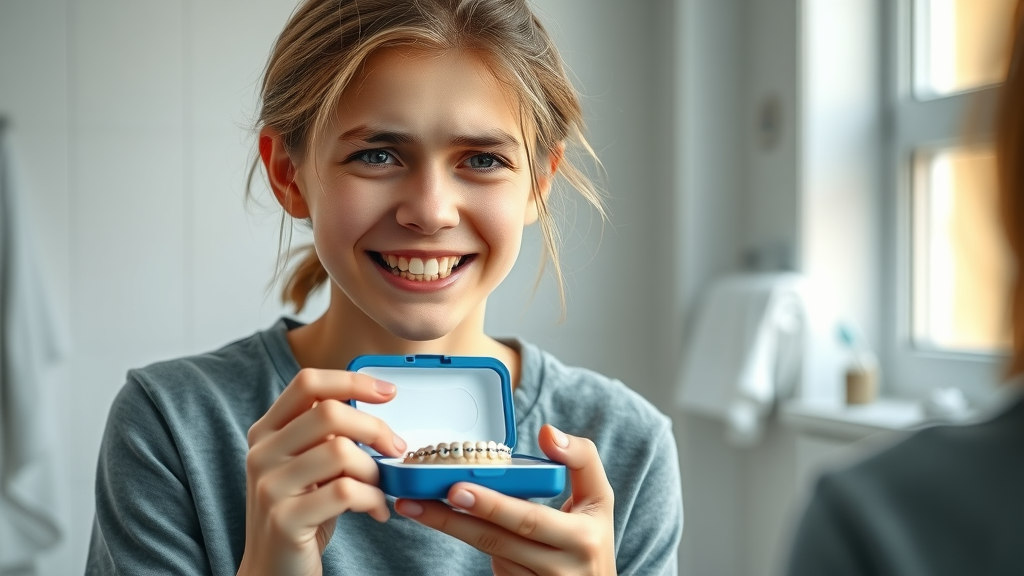


Write A Comment